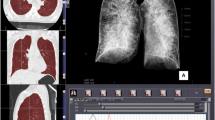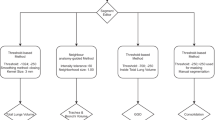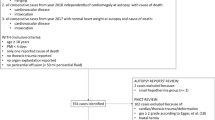Abstract
Segmentation of the lungs using post-mortem computed tomography (PMCT) data was so far not feasible due to post-mortem changes such as internal livores. Recently, an Osirix plug-in has been developed allowing automatically segmenting lungs also in PMCT data. The aim of this study was to investigate if the Hounsfield unit (HU) profiles obtained in PMCT data of the segmented lung tissue present with specific behaviour in relation to the cause of death. In 105 PMCT data sets of forensic cases, the entire lung volumes were segmented using the Mia Lite plug-in on Osirix. HU profiles of the lungs were generated and correlated to cause of death groups as assessed after forensic autopsy (cardiac death, fatal haemorrhage, craniocerebral injury, intoxication, drowning, hypothermia, hanging and suffocation). Especially cardiac death cases, intoxication cases, fatal haemorrhage cases and hypothermia cases showed very specific HU profiles. In drowning, the profiles showed two different behaviours representing wet and dry drowning. HU profiles rather varied in craniocerebral injury cases, hanging cases as well as in suffocation cases. HU profiles of the lungs segmented from PMCT data may support the cause of death diagnosis as they represent specific morphological changes in the lungs such as oedema, congestion or blood loss. Especially in cardiac death, intoxication, fatal haemorrhage, hypothermia and drowning cases, HU profiles may be very supportive for the forensic pathologist.



Similar content being viewed by others
References
Roberts IS, Benamore RE, Benbow EW, Lee SH, Harris JN, Jackson A, Mallett S, Patankar T, Peebles C, Roobottom C, Traill ZC (2012) Post-mortem imaging as an alternative to autopsy in the diagnosis of adult deaths: a validation study. Lancet 379:136–142
Jackowski C (2013) Special issue on postmortem imaging 2013. Forensic Sci Int 225:1–2
Persson A, Lindblom M, Jackowski C (1987) (2011) A state-of-the-art pipeline for postmortem CT and MRI visualization: from data acquisition to interactive image interpretation at autopsy. Acta Radiol Stockh Swed 52:522–536
Scholing M, Saltzherr TP, Fung Kon Jin PHP, Ponsen KJ, Reitsma JB, Lameris JS, Goslings JC (2009) The value of postmortem computed tomography as an alternative for autopsy in trauma victims: a systematic review. Eur Radiol 19:2333–2341
Le Blanc-Louvry I, Thureau S, Duval C, Papin-Lefebvre F, Thiebot J, Dacher JN, Gricourt C, Touré E, Proust B (2013) Post-mortem computed tomography compared to forensic autopsy findings: a French experience. Eur Radiol 23:1829–1835
Michiue T, Sakurai T, Ishikawa T, Oritani S, Maeda H (2012) Quantitative analysis of pulmonary pathophysiology using postmortem computed tomography with regard to the cause of death. Forensic Sci Int 220:232–238
Arthurs OJ, Guy A, Kiho L, Sebire NJ (2015) Ventilated postmortem computed tomography in children: feasibility and initial experience. Int J Legal Med 129:1113–1120
Schulze C, Hoppe H, Schweitzer W, Schwendener N, Grabherr S, Jackowski C (2013) Rib fractures at postmortem computed tomography (PMCT) validated against the autopsy. Forensic Sci Int 233:90–98
Jackowski C, Thali M, Sonnenschein M, Aghayev E, Yen K, Dirnhofer R, Vock P (2004) Visualization and quantification of air embolism structure by processing postmortem MSCT data. J Forensic Sci 49:1339–1342
Egger C, Vaucher P, Doenz F, Palmiere C, Mangin P, Grabherr S (2012) Development and validation of a postmortem radiological alteration index: the RA-Index. Int J Legal Med 126:559–566
Dedouit F, Telmon N, Costagliola R, Otal P, Florence LL, Joffre F, Rougé D (2007) New identification possibilities with postmortem multislice computed tomography. Int J Legal Med 121:507–510
Sidler M, Jackowski C, Dirnhofer R, Vock P, Thali M (2007) Use of multislice computed tomography in disaster victim identification—advantages and limitations. Forensic Sci Int 169:118–128
Ward HE, Clarke BE, Zimmerman PV, Cleary MI (2002) The decline in hospital autopsy rates in 2001. Med J Aust 176:91
Jackowski C, Grabherr S, Schwendener N (2013) Pulmonary thrombembolism as cause of death on unenhanced postmortem 3T MRI. Eur Radiol 23:1266–1270
Jackowski C, Schwendener N, Grabherr S, Persson A (2013) Post-mortem cardiac 3-T magnetic resonance imaging: visualization of sudden cardiac death? J Am Coll Cardiol 62:617–629
Geller SA (1984) Religious attitudes and the autopsy. Arch Pathol Lab Med 108:494–496
http://www.mia-solution.com/. 2015.
Shiotani S, Kobayashi T, Hayakawa H, Kikuchi K, Kohno M (2011) Postmortem pulmonary edema: a comparison between immediate and delayed postmortem computed tomography. Leg Med Tokyo Jpn 13:151–155
Orlowski JP, Szpilman D (2001) Drowning. Rescue, resuscitation, and reanimation. Pediatr Clin North Am 48:627–646
Schweitzer W, Thali M, Giugni G, Winklhofer S (2014) Postmortem pulmonary CT in hypothermia. Forensic Sci Med Pathol 10:557–569
Hyodoh H, Watanabe S, Katada R, Hyodoh K, Matsumoto H (2013) Postmortem computed tomography lung findings in fatal of hypothermia. Forensic Sci Int 231:190–194
Zech W-D, Jackowski C, Buetikofer Y, Kara L (2014) Characterization and differentiation of body fluids, putrefaction fluid, and blood using Hounsfield unit in postmortem CT. Int J Legal Med 128:795–802
Author information
Authors and Affiliations
Corresponding author
Rights and permissions
About this article
Cite this article
Schober, D., Schwendener, N., Zech, WD. et al. Post-mortem CT: Hounsfield unit profiles obtained in the lungs with respect to the cause of death assessment. Int J Legal Med 131, 199–210 (2017). https://doi.org/10.1007/s00414-016-1454-9
Received:
Accepted:
Published:
Issue Date:
DOI: https://doi.org/10.1007/s00414-016-1454-9




